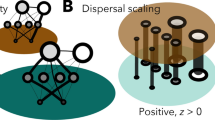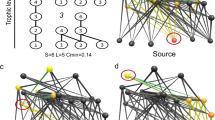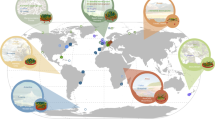Abstract
Food-web models use the effect size of trophic interactions to predict consumer–resource dynamics1,2,3. These models anticipate that strong effects of consumers increase spatial and temporal variability in abundance of species, whereas weak effects dampen fluctuations4,5,6. Empirical evidence indicates that opposite patterns may occur in natural assemblages7. Here I show that spatial variance in the distribution of resource populations is sensitive to changes in the variance of the trophic interaction, in addition to the mean effect of consumers, relative to other causes of spatial variability. Simulations indicate that both strong and weak direct effects of consumers can promote spatial variability in abundance of resources, but only trophic interactions with a large mean effect size can reduce variation. Predictions of the model agree with the results of repeated field experiments and are consistent with data from published consumer–resource interactions, proving to be robust across widely varying environmental conditions and species’ life histories. Thus, food-web models that embody variance in trophic interactions may have increased capacity to explain the wide range of effects of consumers documented in empirical studies.
This is a preview of subscription content, access via your institution
Access options
Subscribe to this journal
Receive 51 print issues and online access
$199.00 per year
only $3.90 per issue
Buy this article
- Purchase on Springer Link
- Instant access to full article PDF
Prices may be subject to local taxes which are calculated during checkout



Similar content being viewed by others
References
Lawton, J. H. in Ecological Concepts (ed. Cherret, J. M.) 43–78 (Blackwell Scientific, Oxford, 1989).
Paine, R. T. Food webs: linkage, interaction strength and community infrastructure. J. Anim. Ecol. 49, 667–685 (1980).
Paine, R. T. Food-web analysis through field measurement of per capita interaction strength. Nature 355, 73–75 (1992).
May, R. M. Stability And Complexity In Model Ecosystems (Princeton Univ. Press, Princeton, 1973).
Polis, G. A. & Strong, D. R. Food web complexity and community dynamics. Am. Nat. 147, 813– 846 (1996).
McCann, K., Hastings, A. & Huxel, G. R. 1998. Weak trophic interactions and the balance of nature. Nature 395, 794– 798 (1998).
Berlow, E. L. Strong effects of weak interactions in ecological communities. Nature 398, 330–334 ( 1999).
Fairweather, P. G. Predation can increase variability in the abundance of prey on seashores. Oikos 53, 87–92 (1988).
Taylor, R. L. Aggregation, variance and the mean. Nature 189, 732–735 (1961).
Osenberg, C. W., Sernelle, O. & Cooper, S. D. Effect size in ecological experiments: the application of biological models in meta-analysis. Am. Nat. 150 , 798–812 (1997).
Sousa, W. P. Intertidal mosaics: patch size, propagule availability, and spatially variable patterns of succession. Ecology 65, 1918 –1935 (1984).
Dungan, M. L. in Predation: Direct And Indirect Impacts On Aquatic Communities (eds Karefoot, W. C. & Sih, A.) 188–220 (Univ. Press New England, Hanover, 1987).
Martin, T. H., Wright, R. A. & Crowder, L. B. Non-additive impact of blue crabs and spot on their prey assemblages. Ecology 70, 1935– 1942 (1989).
Dethier, M. & Duggins, D. Variation in strong interactions in the intertidal zone along a geographical gradient: a Washington-Alaska comparison. Mar. Ecol. Prog. Ser. 50, 97 –105 (1988).
Menge, B. A., Lubchenco, J., Gaines, S. D. & Ashkenas, L. R. A test of the Menge-Sutherland model of community organization in a tropical rocky intertidal food web. Oecologia 71, 75–89 (1986).
Lubchenco, J. et al. Structure, persistence and role of consumers in a tropical rocky intertidal community (Taboguilla Island, Bay of Panama). J. Exp. Mar. Ecol. 77, 23–73 (1984).
Berlow, E. L. & Navarrete, S. A. Spatial and temporal variation in rocky intertidal community organization: lessons from repeating field experiments. J. Exp. Mar. Biol. Ecol. 214, 195– 229 (1997).
Sousa, W. Experimental investigations of disturbance and ecological succession in a rocky intertidal algal community. Ecol. Monogr. 49, 227–254 (1979).
Dungan, M. L. Three-way interactions: barnacles, limpets, and algae in a sonoran desert rocky intertidal zone. Am. Nat. 127, 292 –316 (1986).
Morrison, D. Comparing fish and urchin grazing in shallow and deeper coral reef algal communities. Ecology 69, 1367–1382 (1988).
Anderson, M. J. & Underwood, A. J. Effects of gastropods grazers on recruitment and succession of an estuarine assemblage: a multivariate and univariate approach. Oecologia 109 , 442–453 (1997).
Navarrete, S. A. Variable predation: effects of whelks on a mid-intertidal successional community. Ecol. Monogr. 66, 301– 321 (1996).
Wootton, T. J. Size-dependent competition: effects on the dynamics vs. the end point of mussel bed succession. Ecology 74, 195– 206 (1993).
Lubchenco, J. & Menge, B. A. Community development and persistence in a low rocky intertidal zone. Ecol. Monogr. 48, 67–94 (1978).
Menge, B. A. et al. The keystone species concept: variation in interaction strength in a rocky intertidal habitat. Ecol. Monogr. 64, 249–286 (1994).
Sanford, E. Regulation of keystone predation by small changes in ocean temperature. Science 283, 2095–2097 ( 1999).
Benedetti-Cecchi, L. Predicting direct and indirect interactions during succession in a midlittoral rocky shore assemblage. Ecol. Monogr. 70, 45–72 (2000).
Underwood, A. J. in Frontiers Of Population Ecology (eds Floyd, R. B., Sheppard, A. W. & De Barro, P. J.) 369–389 (CSIRO, Melbourne, 1996).
Smith, S. V. & Buddemeier, R. W. Global change and coral reef ecosystems. Annu. Rev. Ecol. Syst. 23, 89 –118 (1992).
Menconi, M., Benedetti-Cecchi, L. & Cinelli, F. Spatial and temporal variability in the distribution of algae on rocky shores in the northwest Mediterranean. J. Exp. Mar. Biol. Ecol. 233, 1–23 (1999).
Acknowledgements
I thank M. J. Anderson and F. Micheli for helpful comments on the manuscript. F. Bulleri, I. Bertocci and M. Menconi provided invaluable assistance in the field. This research was supported by the European Community and by a grant from the University of Pisa.
Author information
Authors and Affiliations
Corresponding author
Rights and permissions
About this article
Cite this article
Benedetti-Cecchi, L. Variance in ecological consumer–resource interactions. Nature 407, 370–374 (2000). https://doi.org/10.1038/35030089
Received:
Accepted:
Issue Date:
DOI: https://doi.org/10.1038/35030089
This article is cited by
-
A state-space approach to understand responses of organisms, populations and communities to multiple environmental drivers
Communications Biology (2021)
-
Variability effects by consumers exceed their average effects across an environmental gradient of mussel recruitment
Oecologia (2021)
-
Interactions between predation and disturbances shape prey communities
Scientific Reports (2018)
-
Transient recovery dynamics of a predator–prey system under press and pulse disturbances
BMC Ecology (2017)
-
Temporal variability within disturbance events regulates their effects on natural communities
Oecologia (2011)
Comments
By submitting a comment you agree to abide by our Terms and Community Guidelines. If you find something abusive or that does not comply with our terms or guidelines please flag it as inappropriate.



